|
LabGuy's World:
What is a Video Tape Recorder? Page 1 By Richard Diehl, ©2011 Labguy's World dot com 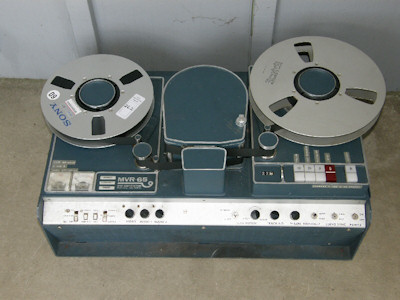 MVR Corporation MVR-65 one inch video tape recorder circa 1965 The function of a video tape recorder is to record, store and reproduce a television signal with both picture and sound on magnetic tape. These machines can take many forms including, but not limited to, open reels, cassettes and cartridges. A video tape recorder is also refered to as a "VTR" for short. VTRs can be huge or very tiny. The engineering that had gone into their evolution was nothing short of brilliant. The hay day of the VTR was from the mid 1950s to the mid 2000s. The time of the video tape recorder had passed by the start of the new melinium as new innovative video recording methods, based on digital technolgies, superseded the old and rang in the new. Most video today is recored directly to solid state memories, edited on computers and ultimately stored long term on computer magnetic and optical hard drives. In the earliest days of television, all broadcasts were live. If you saw Uncle Milty in a dress on TV, he was in a dress right at that moment. Usually. In the USA, when the television industry was very young, the size of the nation caused a serious problem for network broadcasters. The nation spanned four time zones. So, the six o'clock news in New York was seen in San Francisico at 3 o'clock. Or the network had to repeat the news each hour for each time zone. This was a seriously expensive problem. The crews had to be paid for four hours instead of one. Transcontinental coax distrubution had to be purchase for the three of those hours. Not cheap either. 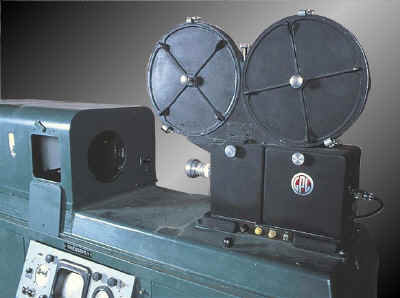 A kinescope recorder at the Canada Museum of Science & Technology in Ottawa Author: Peter Lindell, Canada Science and Technology Museum The earliest form of television recording consisted of pointing a movie camera at a TV monitor and filming the program. This method was used for several years and was called kinescope recording. The film would be taken immediatley, starting about 15 minutes into a program, dashed to another facility for developing and then dashed back to the studio, hopefully within the hour, to then be played on a projector and broadcast to the next time zone. This was repeated each hour until the three western time zones had been serviced. Then the film was simply tossed out. Kinescopes were EXTREMELY expensive in materials and labor. Not to even mention the inferior quality of the process. From the beginning, the idea of recording television onto magnetic tape was persued. Audio recording, by the arrival of television, was a reasonably mature and well understood technology. A varying electrical signal, sound detected by a microphone for instance, was converted to magnetic impressions on a metalic medium. First, steel wire and later plastic based tape. View the video above to see how magnetic tape is really just Sticky Tape and Rust! Electrical sound signals consist of waves that fall into a frequency range between approximately 20 cycles per second (Hz) to 20,000 cycles per second and varying in amplitude or loudness. Applied to an electromagnet with a fine gap, while the tape is pulled past it at a constant speed, will leave tiny magnets printed on the tape. On playback, the tape is pulled past this same gapped electromagnet, called a reproducing head, and the printed magnets now induce a current in the wire coil of the head. This siganl is amplified and a reasonably faithful reproduction of the original sound can be produced. This example is overly simplified, but makes the point. This method of recording television by moving tape past a fixed head at high speed is refered to as longitudinal video recording. Tape has minum detail just like film. In film this is referred to as grain. This is smallest area that can faithfully reproduce a detail in the image. In magentic tape, there is minimum sized magnet that faithfully reproduces one cycle of the electrical signal. In the earliest tape this was about 1,000 cycles per inch of tape. So, if a signal with an upper limit of 20,000 cycles per second is to be recorded and reproduced, the tape needs to move past the head at a speed of at least twenty inches per second. In fact, early professional tape recorders ran at a tape speed of thrity inches per second or 30 IPS. This relationship of signal frequency to tape speed is referred to as the time and space relationship. The faster the tape moves, the higher the frequency that can be recorded... in theory. 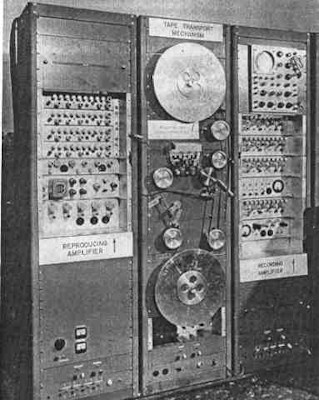
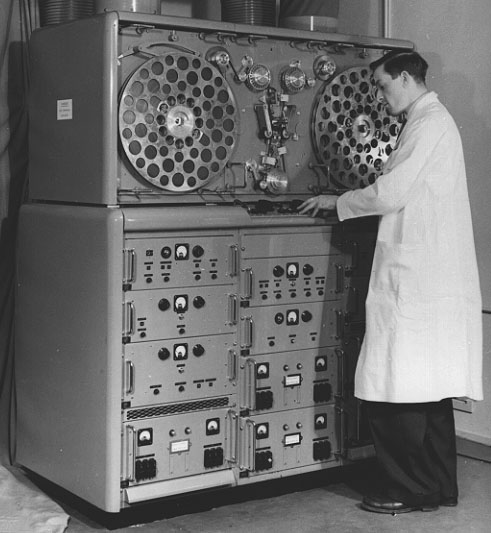 RCA Longitudinal video tape recorder circa 1950, tape speed up to 360 IPS American television signals contain frequencies ranging from almost zero and extending all the way up to four and a half million cycles per second. First, simply speeding up the tape to the required four thousand five hundred inches per second was not practical. The edge of the tape reels would break the sound barrier and you would need two hundred fifty seven miles of tape just to record one hour of video. No machine could cope with the stresses and control required to make that work. That did not prevent engineers from trying it anyway. The results were predictable. Above, are two photos of an RCA longitudinal VTR and the British Broadcasting Corporation's VERA, which stood for Vistion Electronic Recording Aperatus. Both machines were huge, complex and ungainly and produced mediocre results at best. In Britain, the VERA broadcasts were quickly named wobbly TV because of the inherant instabilities of this recording method. 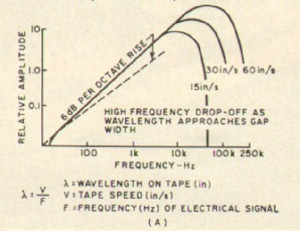
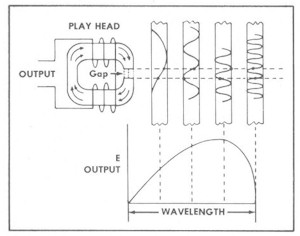 Response of a tape recording / playback head at various tape speeds and the gap effect. Secondly, the recording head can not work over a range of frequencies that great if the video signal is recorded directly onto the tape as in audio recording. The width of the gap in the recording head determines the upper and lower frequency range that can be reproduced by that head. Make the gap small enough to record the upper frequencies and the lower frequencies are so weak as to not be detectable. Video spans a range of 15 octaves, or 15 doubling of frequencies. This a ratio of about 32,000 to 1 as compared to audio's 200 to 1. Even at audio frequencies, serious frequency equalization is required to provide a uniform final repsonse.That is to say, all frequencies in the range are reproduced at the same relative level. To solve the speed problem, by the late 1940s several engineers developed schemes of moving the tape past a moving head. The earliest American patent for this went to Earl Masterson of Armour Research. Though, in reality, there are several European patents for this prior to Masterson's work. However, Earl Masterson was the first to describe the use of moving heads to extend frequency repsonse for wideband recording where all former patents were trying to extend recording time. The engineering team at Ampex, a major tape recorder manufacturer located in Redwood City California, developed the first practical, and more importantly the first commerically successful video recording aperatus in 1954. This team was lead by Charles Ginsburg and was comprised of several brilliant young engineers. You can read that remarkable story right here: The Birth of the Video Recording By Charles P. Ginsburg. 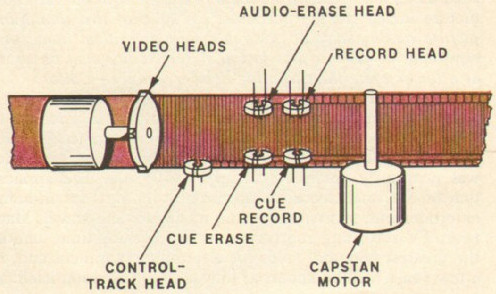 Transverse Recording Scheme By scanning the tape with heads mounted to the rim of a wheel, the longitudinal tape speed could be reduced dramatically. From this method, two schemes emerged. The first successful scheme became known as transverse scanning. A wheel is postioned at 90 degrees to the tape. The tape is two inches wide, and is supported in a curved guide by means of a light vacuum. The guide precisely applies the tape to the edge of the head wheel, spanning approximatley 90 degrees of that wheel. Due to signal processing breakthroughs, to be explained in a moment, the required head to tape speed is now a reasonable one thousand five hundred inches per second. The width of the video heads is reduced to produce equally spaced tracks of about 240 per inch along the tape. The next problem to be solved was the problem of frequency range. As mentioned before, the range of video frequencies exceeds the range that a practical tape and head system can reproduce. So, the video signal is converted to a radio-like signal called FM. This immediately produced two advantages. If the video is impressed onto a carrier that ranges from two to four megahertz, the frequency ratio is now only two to one. Easily recorded and reproduced by fine gapped heads and practical resolution tape. On top of that, the FM signal is always at 100% power, so the amount of noise in the signal becomes constant regardless of the brightness level of the image. In direct recording, low brightness meant a low signal on tape. At low levels the natural noise of the tape and amplifiers becomes quite noticable. Worse yet, the human eye percieves this noise best in the dark regions of the picture. FM solved that problem almost perfectly. At the least, the noise was of a constant and very low level in all parts of the image regardless of brightness. 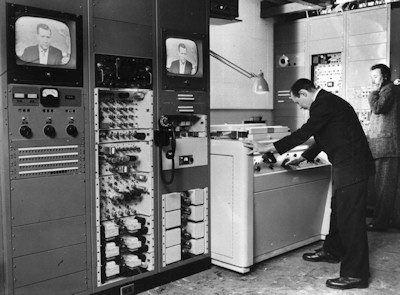 Douglas Edwards and the News, recorded in New York, West Coast delayed broadcast for the first time, November 20, 1956 The transverse scanning method of video tape recording, by necessity, made the VTR extremely large, complex and expensive. But, compared to kinescope film recording, it was actually cheaper to operate over any time period when compared to the film and labor costs. Plus, tape could be erased and reused, multiplying the savings even farther! The first use put into practice by the networks was for west coast delay in news broadcasts and other netwrok programming. This was great for television networks and broadcasters. But when did consumer VTRs become practical? Well, Binky, that was still a few years off. Another breakthrough would be required to make the machines smaller and economical enough for the average consumer. [HOME] [Next Page] Created: June 23, 2011, Last updated: July 11, 2011 |